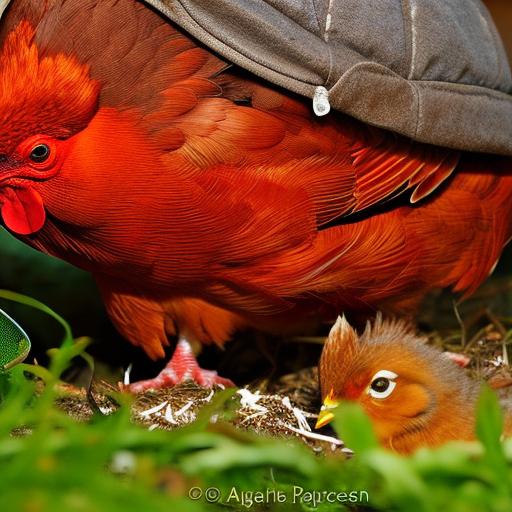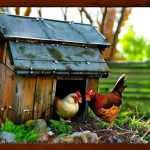Keeping chickens warm during cold weather is essential for their health and well-being. Chickens are susceptible to frostbite and other cold-related illnesses, so it’s important to provide them with a warm and comfortable environment. While heat lamps are commonly used to keep chickens warm, they can be dangerous and expensive. In this blog post, we’ll explore natural ways to keep your chickens warm without a heat lamp.
Key Takeaways
- Chickens have natural heating mechanisms that allow them to survive cold weather without a heat lamp.
- Choosing the right chicken coop and insulating it properly can help retain maximum heat.
- Adequate bedding and high-fat foods can provide warmth and comfort for chickens.
- Chicken sweaters and jackets can be used for added warmth, but proper ventilation is still necessary.
- Monitoring your chickens’ behavior and health during cold weather is crucial for their well-being.
Understanding the Natural Heating Mechanisms of Chickens
Chickens have natural mechanisms to regulate their body temperature. One of these mechanisms is fluffing their feathers. When chickens fluff their feathers, it creates an insulating layer of air that helps to keep them warm. Another natural heating mechanism is roosting together. Chickens naturally roost together at night, which helps to generate and retain body heat. Understanding these mechanisms can help you create a warm and comfortable environment for your chickens.
Choosing the Right Chicken Coop for Cold Weather
The right chicken coop can make a big difference in keeping your chickens warm during cold weather. Look for a coop that is well-insulated and draft-free. Insulation helps to retain heat and keep the coop warm, while preventing drafts ensures that cold air doesn’t enter the coop. Additionally, consider choosing a coop with a south-facing window. This allows natural sunlight to enter the coop, providing warmth during the day.
Insulating the Chicken Coop for Maximum Heat Retention
Insulating your chicken coop is crucial for maximum heat retention. Use materials such as straw, hay, or foam board to insulate the walls, ceiling, and floor of the coop. These materials provide an extra layer of insulation that helps to trap heat inside the coop. Additionally, consider using weatherstripping around doors and windows to prevent drafts.
Providing Adequate Bedding for Warmth and Comfort
Bedding is important for keeping your chickens warm and comfortable. Use materials such as straw, hay, or wood shavings to provide a thick layer of bedding on the coop floor. This bedding helps to insulate the floor and provides a soft and warm surface for your chickens to rest on. Make sure to regularly clean and replace the bedding to maintain cleanliness and prevent moisture build-up.
Using Chicken Sweaters and Jackets for Added Warmth

Chicken sweaters and jackets can provide added warmth for your chickens, especially during extremely cold weather. These can be purchased or made at home using old sweaters or blankets. Chicken sweaters are designed to cover the chicken’s body, leaving only the head and legs exposed. They provide an extra layer of insulation and help to keep the chicken’s body temperature regulated.
Feeding Your Chickens High-Fat Foods for Natural Insulation
Feeding your chickens high-fat foods can help provide natural insulation. Foods such as sunflower seeds or mealworms are high in fat and can help keep your chickens warm during cold weather. These foods provide extra energy for your chickens, which helps them generate heat. Additionally, make sure to provide a well-balanced diet that includes all the necessary nutrients for your chickens’ overall health.
Ensuring Proper Ventilation to Prevent Moisture Build-up
Proper ventilation is important in the chicken coop to prevent moisture build-up. Moisture build-up can lead to condensation, which can cause respiratory problems for your chickens. Make sure to have vents or windows in the coop that allow for fresh air circulation without creating drafts. It’s important to strike a balance between insulation and ventilation to maintain a healthy environment for your chickens.
Supplementing with Heat-Emitting Bulbs and Panels
In some cases, you may need to supplement natural heating mechanisms with heat-emitting bulbs or panels. These should be used with caution and monitored closely to prevent overheating or fires. Heat-emitting bulbs or panels can provide additional warmth in areas of the coop that may be colder or less insulated. Make sure to position them safely and keep a close eye on the temperature to ensure the safety of your chickens.
Monitoring Your Chickens’ Behavior and Health during Cold Weather
It’s important to monitor your chickens’ behavior and health during cold weather. Look for signs of distress or illness, such as lethargy, loss of appetite, or difficulty breathing. If you notice any concerning symptoms, make adjustments to their environment as needed. This may include adding more insulation, adjusting ventilation, or providing additional heat sources. Regularly check on your chickens and make sure they have access to fresh water and food.
In conclusion, keeping chickens warm during cold weather is essential for their health and well-being. By understanding their natural heating mechanisms and making adjustments to their environment, you can provide a warm and comfortable home for your feathered friends. Choose the right chicken coop, insulate it properly, provide adequate bedding, and consider using chicken sweaters or jackets for added warmth. Feed your chickens high-fat foods for natural insulation and ensure proper ventilation to prevent moisture build-up. Supplement with heat-emitting bulbs or panels if necessary, but always monitor your chickens’ behavior and health during cold weather. With these tips, you can keep your chickens warm without relying on a heat lamp.
If you’re interested in learning more about how to keep chickens warm without a heat lamp, you might also find this article on chicken coop portage from Poultry Wizard helpful. It provides valuable insights on how to design and build a portable chicken coop that can be easily moved to provide your chickens with the warmth they need during colder months. Check it out here.
FAQs
What is the ideal temperature for chickens?
Chickens are comfortable in temperatures ranging from 40-85°F. However, they can tolerate temperatures as low as 20°F and as high as 95°F.
Why should I avoid using a heat lamp for my chickens?
Heat lamps can be a fire hazard and can cause burns to chickens. They can also disrupt the natural circadian rhythm of chickens, leading to health problems.
What are some alternative ways to keep chickens warm?
Some alternative ways to keep chickens warm include using deep litter bedding, insulating the coop, providing a draft-free environment, and using heated waterers.
What is deep litter bedding?
Deep litter bedding is a method of keeping the coop warm by allowing the bedding to build up over time. The bedding provides insulation and generates heat as it decomposes.
How can I insulate my coop?
You can insulate your coop by using materials such as foam board, fiberglass insulation, or reflective insulation. It is important to ensure proper ventilation when insulating to prevent moisture buildup.
What should I do if the temperature drops below freezing?
If the temperature drops below freezing, you can provide additional warmth by using a heated waterer, adding extra bedding, and using a coop heater. It is important to monitor the temperature regularly to ensure the chickens are comfortable.
Meet Walter, the feathered-friend fanatic of Florida! Nestled in the sunshine state, Walter struts through life with his feathered companions, clucking his way to happiness. With a coop that’s fancier than a five-star hotel, he’s the Don Juan of the chicken world. When he’s not teaching his hens to do the cha-cha, you’ll find him in a heated debate with his prized rooster, Sir Clucks-a-Lot. Walter’s poultry passion is no yolk; he’s the sunny-side-up guy you never knew you needed in your flock of friends!







